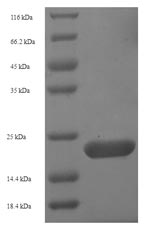The recombinant human AQP4 protein is a fusion protein consists of the human AQP4 protein (253-323aa) partnered with the N-terminal 6xHis-SUMO tag. It was produced in the E.coli. This recombinant AQP4 protein's purity is greater than 90% determined by SDS-PAGE. After electrophoresis, there is a 22 kDa protein band presented on the gel.
Aquaporin 4 (AQP4) is one of the three types of aquaporins (AQPs) that have been described in astrocytes. AQP4 protein is the predominant aquaporin found in brain and has an important role in brain water homeostasis. Its expression is mainly confined to astrocytes, but its distribution and levels of expression vary between different brain regions. In the cerebral cortex, AQP4 expression is particularly abundant in astrocytes aligning blood vessels. Recent researches found the correlations of AQP4 expression and polymorphism with diabetic retinopathy. Upregulation of aqp4 improves blood–brain barrier integrity and perihematomal edema following intracerebral hemorrhage. One findings suggested that anti-AQP4 autoantibodies promote ATP release from astrocytes and induce mechanical pain in rats. Nevertheless, the predominant pattern of AQP4 in the central nervous system is highly polarized, especially in astrocytes in the proximity of or in contact with blood vessels, the ependymal layer, and pia.






